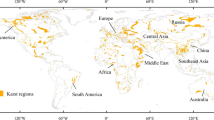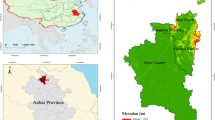Abstract
Greenhouse gas emission of carbon dioxide (CO2) is one of the major factors causing global climate change. Urban green space plays a key role in regulating the global carbon cycle and reducing atmospheric CO2. Quantifying the carbon stock, distribution and change of urban green space is vital to understanding the role of urban green space in the urban environment. Remote sensing is a valuable and effective tool for monitoring and estimating aboveground carbon (AGC) stock in large areas. In the present study, different remotely-sensed vegetation indices (VIs) were used to develop a regression equation between VI and AGC stock of urban green space, and the best fit model was then used to estimate the AGC stock of urban green space within the beltways of Xi’an city for the years 2004 and 2010. A map of changes in the spatial distribution patterns of AGC stock was plotted and the possible causes of these changes were analyzed. Results showed that Normalized Difference Vegetation Index (NDVI) correlated moderately well with AGC stock in urban green space. The Difference Vegetation Index (DVI), Ratio Vegetation Index (RVI), Soil Adjusted Vegetation Index (SAVI), Modified Soil Adjusted Vegetation Index (MSAVI) and Renormalized Difference Vegetative Index (RDVI) were lower correlation coefficients than NDVI. The AGC stock in the urban green space of Xi’an in 2004 and 2010 was 73,843 and 126,621 t, respectively, with an average annual growth of 8,796 t and an average annual growth rate of 11.9%. The carbon densities in 2004 and 2010 were 1.62 and 2.77 t/hm2, respectively. Precipitation was not an important factor to influence the changes of AGC stock in the urban green space of Xi’an. Policy orientation, major ecological greening projects such as “transplanting big trees into the city” and the World Horticultural Exposition were found to have an important impact on changes in the spatiotemporal patterns of AGC stock.
Similar content being viewed by others
References
Ajtay G L, Ketner P, Duvigneaud P. 1979. Terrestrial production and phytomass. In: Bolin B, Degens E T, Kempe S, et al. The Global Carbon Cycle. New York: John Wiley & Sons, SCOPE Report No. 13: 129–182.
Barati S, Rayegani B, Saati M, et al. 2011. Comparison the accuracies of different spectral indices for estimation of vegetation cover fraction in sparse vegetated areas. The Egyptian Journal of Remote Sensing and Space Science, 14(1): 49–56.
Baret F, Guyot G. 1991. Potentials and limits of vegetation indices for LAI and APAR assessment. Remote Sensing of Environment, 35(2–3): 161–173.
Birth G S, McVey G R. 1968. Measuring the color of growing turf with a reflectance spectrometer. Agronomy Journal, 60(6): 640–643.
Chang X X, Che K J, Song C F, et al. 1997. Biomass and nutrient element accumulation of Sabina prezewalskii forest community. Journal of Northwest Forestry College, 12(1): 23–28. (in Chinese)
Chow P, Rolfe G L. 1989. Carbon and hydrogen contents of short rotation biomass of five hardwood species. Wood and Fiber Science, 21(1): 30–36.
Du Y, Teillet P M, Cihlar J. 2002. Radiometric normalization of multitemporal high-resolution satellite images with quality control for land cover change detection. Remote Sensing of Environment, 82(1): 123–134.
Guan D S, Chen Y J, Huang F F. 1998. The storage and distribution of carbon in urban vegetation and its roles in balance of carbon and oxygen in Guangzhou. China Environmental Science, 18(5): 437–441. (in Chinese)
He H Z, Huang L H, Duan X, et al. 2007. Study on biomass in main afforestation tree species of the second ring forest-belt of Guiyang. Guizhou Science, 25(3): 33–39. (in Chinese)
Houghton R A. 2005. Aboveground forest biomass and the global carbon balance. Global Change Biology, 11(6): 945–958.
Huete A R. 1988. A soil-adjusted vegetation index (SAVI). Remote Sensing of Environment, 25(3): 295–309.
Huete A R, Liu H Q, Batchily K, et al. 1997. A comparison of vegetation indices global set of TM images for EOS-MODIS. Remote Sensing of Environment, 59(3): 440–451.
Ji L, Peters A J. 2007. Performance evaluation of spectral vegetation indices using a statistical sensitivity function. Remote Sensing of Environment, 106(1): 59–65.
Jiang Z Y, Huete A R, Didan K, et al. 2008. Development of a two-band enhanced vegetation index without a blue band. Remote Sensing of Environment, 112(10): 3833–3845.
Jo H K, McPherson E G. 1995. Carbon storage and flux in urban residential greenspace. Journal of Environmental Management, 45(2): 109–133.
Jo H K. 2002. Impacts of urban greenspace on offsetting carbon emissions for middle Korea. Journal of Environmental Management, 64(2): 115–126.
Johnston M H, Homann P S, Engstrom J K, et al. 1996. Changes in ecosystem carbon storage over 40 years on an old-field/forest landscape in east-central Minnesota. Forest Ecology and Management, 83(1–2): 17–26.
Kanniah K D, Muhamad N, Kang C S. 2013. Remote sensing assessment of carbon storage by urban forest. IOP Conference Series: Earth and Environmental Science. IOP Publishing, 18(1): 012151.
Karl T R, Nicholls N, Gregory J. 1997. The coming climate. Scientific American, 276(5): 78–83.
Li F, Jiang L, Wang X F, et al. 2013. Estimating grassland aboveground biomass using multitemporal MODIS data in the West Songnen Plain, China. Journal of Applied Remote Sensing, 7(1), 073546, doi:10.1117/1.JRS.7.073546.
Li H K, Lei Y C. 2010. Estimation and Evaluation of Forest Biomass Carbon Storage in China. Beijing: Chinese Forestry Press. (in Chinese)
Li X N, Guo Q X, Wang X C, et al. 2010. Allometry of understory tree species in a natural secondary forest in northeast China. Scientia Silvae Sinicae, 46(8): 22–32. (in Chinese)
Li Z H, He L X, Zhou Y P, et al. 1996. Studies of biomass and productivity of Metasequoia glyphostrobodes plantation. Journal of Central-South Forestry University, 16(2): 47–51. (in Chinese)
Liu G H, Fu B J, Fang J Y. 2000. Carbon dynamics of Chinese forests and its contribution to global carbon balance. Acta Ecologica Sinica, 20(5): 733–740. (in Chinese)
Lu X Y, Chen S X, Li M Q, et al. 1990. Resarch on the biomass of Paulownia. Forest Research, 3(5): 421–426. (in Chinese)
Ma Q Y. 1989. A study on the biomass of Chinese pine forests. Journal of Beijing Forestry University, 11(4): 1–10. (in Chinese)
McPherson E G. 1998. Atmospheric carbon dioxide reduction by Sacramento’s urban forest. Journal of Arboriculture, 24(4): 215–223.
Melillo J M, Callaghan T V, Woodward F I, et al. 1990. Effects on ecosystems. Climate Change: The IPCC Scientific Assessment, 283–310.
Myeong S, Nowak D J, Duggin M J. 2006. A temporal analysis of urban forest carbon storage using remote sensing. Remote Sensing of Environment, 101(2): 277–282.
Nowak D J. 1993. Atmospheric carbon reduction by urban trees. Journal of Environmental Management, 37(3): 207–217.
Nowak D J. 1994. Atmospheric carbon dioxide reduction by Chicago’s urban forest. In: McPherson E G, Nowak D J, Rowntree R A. Chicago’s Urban Forest Ecosystem: Results of the Chicago Urban Forest Climate Project. USDA Forest Service General Technical Report NE-186. Radnor, PA: US Department of Agriculture, Forest Service, Northeastern Forest Experiment Station, 83–94.
Nowak D J, Crane D E. 2002. Carbon storage and sequestration by urban trees in the USA. Environmental Pollution, 116(3): 381–389.
Olson J S. 1970. Carbon cycles and temperate woodlands. In: Reichle D E. Analysis of Temperate Ecosystems. Berlin Heidelberg: Springer-Verlag, Ecological Studies Volume 1: 226–241.
Qi J, Chehbouni A, Huete A R, et al. 1994. A modified soil adjusted vegetation index. Remote Sensing of Environment, 48(2): 119–126.
Ren Y, Wei X, Wei X H, et al. 2011. Relationship between vegetation carbon storage and urbanization: a case study of Xiamen, China. Forest Ecology and Management, 261(7): 1214–1223.
Roerink G J, Menenti M, Soepboer W, et al. 2003. Assessment of climate impact on vegetation dynamics by using remote sensing. Physics and Chemistry of the Earth, 28(1–3): 103–109.
Rouse J W Jr, Haas R H, Schell J A, et al. 1974. Monitoring vegetation systems in the great plain with ERTS. In: Freden S C, Mercanti E P, Becker M A. Third Earth Resources Technologye Satellite-1 Symposium-Volume I: Technical Presentations. NASA SP-351. Washington, DC: NASA, 309.
Schlerf M, Atzberger C, Hill J. 2005. Remote sensing of forest biophysical variables using HyMap imaging spectrometer data. Remote Sensing of Environment, 95(2): 177–194.
Schott J R, Salvaggio C, Volchok W J. 1988. Radiometric scene normalization using pseudoinvariant features. Remote Sensing of Environment, 26(1): 1–16.
Shaanxi Provincial Bureau of Statistics. 2005–2006. Statistical Yearbook of Shaanxi. Beijing: China Statistics Press. (in Chinese)
Shaanxi Provincial Bureau of Statistics, NBS Survey Office in Shaanxi. 2007–2011. Statistical Yearbook of Shaanxi. Beijing: China Statistics Press. (in Chinese)
Sivrikaya F, Baskent E Z, Bozali N. 2013. Spatial dynamics of carbon storage: a case study from Turkey. Environmental Monitoring and Assessment, 185(11): 9403–9412.
USDA Forest Products Laboratory. 1952. Chemical Analysis of Wood. Madison, Wisconsin: USDA Forest Service Forest Products Laboratory, Technical Note 235.
Wang Q, Adiku S, Tenhunen J, et al. 2005. On the relationship of NDVI with leaf area index in a deciduous forest site. Remote Sensing of Environment, 94(2): 244–255.
Wang R S, Fang J Y, Gao L, et al. 1996. The Hotpoints for Modern Ecology Research. Beijing: China Science and Technology Press. (in Chinese)
Xi’an Municipal Bureau of Statistics. 2005. Xi’an Statistical Yearbook. Beijing: China Statistics Press. (in Chinese)
Xi’an Municipal Bureau of Statistics, NBS Survey Office in Shaanxi. 2011. Xi’an Statistical Yearbook. Beijing: China Statistics Press. (in Chinese)
Yan F, Wu B, Wang Y J. 2013. Estimating aboveground biomass in Mu Us Sandy Land using Landsat spectral derived vegetation indices over the past 30 years. Journal of Arid Land, 5(4): 521–530.
Yang L. 2011. The build study of Populus tomentosa biomass model in Beijing Daxing District. Hebei Journal of Forestry and Orchard Research, 26(4): 345–348. (in Chinese)
Yao Z Y, Liu J J. 2014. Models for biomass estimation of four shrub species planted in urban area of Xi’an City, Northwest China. Chinese Journal of Applied Ecology, 25(1): 111–116. (in Chinese)
Zhao M, Kong Z H, Escobedo F J, et al. 2010. Impacts of urban forests on offsetting carbon emissions from industrial energy use in Hangzhou, China. Journal of Environmental Management, 91(4): 807–813.
Zhu X W, Xiao Y, Cai W C. 1988. Study on biomass of Populus davidiana natural secondary forest. Science and Technology of Qinghai Agriculture and Forestry, (1): 30–34. (in Chinese)
Author information
Authors and Affiliations
Corresponding author
Rights and permissions
About this article
Cite this article
Yao, Z., Liu, J., Zhao, X. et al. Spatial dynamics of aboveground carbon stock in urban green space: a case study of Xi’an, China. J. Arid Land 7, 350–360 (2015). https://doi.org/10.1007/s40333-014-0082-9
Received:
Revised:
Accepted:
Published:
Issue Date:
DOI: https://doi.org/10.1007/s40333-014-0082-9




